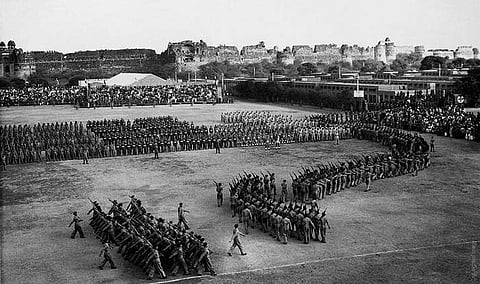

The First Republic Day was more than a national holiday, which it is now. January 26, 1950, was the day the Constitution of India came into effect and when India became a Sovereign, Democratic Republic. This was three years after it gained Independence from the clutches of colonial powers.
Two days before D-Day, Dr Rajendra Prasad was elected as the first President of India while Pandit Jawaharlal Nehru and Sardar Vallabhbhai Patel became the first Prime Minister and Deputy Prime Minister, respectively. The Constitution was signed by cabinet ministers and the preparation for the first Republic Day was on in full gusto.
On the first Republic Day, after paying his respects to the Father of the Nation at Rajghat, Dr Prasad made his way to the Rashtrapati Bhavan, which back then was called the Government Hall. It was in the Durbar Hall that he took his oath as India’s first President and then delivered his speech in both Hindi and English. Next, Nehru and other cabinet ministers were sworn-in. All this in front of more than 500 guests, including the chief guest for the occasion — the first Indonesian President, Sukarno along with his wife.
When it came to the grand parade of the Republic Day, it was held at Major Dhyan Chand National Stadium (back then known as Irwin Amphitheatre), not in Rajpath, where it is held now. In an open state coach, which was 35 years old, Dr Prasad and the chief guests rode from the Rashtrapati Bhavan to the stadium, the lanes of which were lined with people. They were greeted by a 31-gun salute at the amphitheatre. Dr Prasad got onto a jeep and went around the venue while saluting the armed forces. Then came that historic moment — the tricolour flag was hoisted by the new president for the first time, a proud moment not only for all those present but for all Indians alike. “It is for the first time today that we have inaugurated a Constitution which extends to the whole of this country and we see the birth of a federal republic having States which have no sovereignty of their own and which are really members and parts of one federation and one administration,” said Dr Prasad in his speech. India’s highest gallantry awards, Param Vir Chakras, were awarded to four soldiers — two of them posthumously, for their work during the 1947-48 Kashmir Operation. The event was wrapped up after two hours and was devoid of tableaus or acts that can be found in the events nowadays.
A point to note is that protests did erupt in a few places. Like in Mumbai, people protested that worker’s rights were ignored in the Constitution. In Kolkata, police officers were attacked by communists and in Hyderabad, attempts were made to assassinate the Nizam. All said and done, there is no doubt about the fact that the mood was unlike anything that India has ever seen.
Feb 19, 1946
The British government declared that they were sending a Cabinet Mission to India to resolve the whole issue of freedom and Constitution-making
Mar 24, 1946
The Cabinet Mission held prolonged discussions with the major Indian leaders
May 16, 1946
Having failed to secure an agreement, it was decided that the newly-elected legislative assemblies of the provinces were to elect the members of the 389-member strong Constituent Assembly
July-August 1946
Elections were held for the Constituent Assembly and the first members were elected into office
Dec 9, 1946
The Constituent Assembly of India began its first session in Delhi
Dec 11, 1946
Dr Rajendra Prasad was elected the permanent Chairman
Dec 13, 1946
An ‘Objective Resolution’
was moved by Jawaharlal Nehru in the assembly, laying down the underlying principles of the constitution. It finally became the Preamble of the Constitution
Aug 15, 1947
India gained Independence and the Constituent Assembly became a completely sovereign body
Aug 29, 1947
The Constituent Assembly set up a Drafting Committee under the Chairmanship of Dr B R Ambedkar
Feb 1948
Drafting committee prepared the first draft of the Constitution of India
Oct 1948
The second draft was prepared based on the feedback to the first draft
Nov 4, 1948
Dr Ambedkar introduced the final draft of the Constitution and it was discussed for five days
Nov 15th, 1948
The second reading (clause by clause) of the draft started and ended on Oct 17, 1949. About 7,653 amendments were proposed and 2,473 were discussed
Nov 14, 1949
The third reading of the draft started and Dr Ambedkar moved a motion - ‘the Constitution as settled by the Assembly be passed’.
Nov 26, 1949
Draft Constitution was declared as passed and it contained a Preamble, 395 Articles and 8 Schedules
